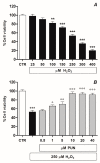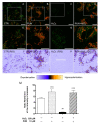Cytoprotective Effects of Punicalagin on Hydrogen-Peroxide-Mediated Oxidative Stress and Mitochondrial Dysfunction in Retinal Pigment Epithelium Cells
- PMID: 33572785
- PMCID: PMC7911437
- DOI: 10.3390/antiox10020192
Cytoprotective Effects of Punicalagin on Hydrogen-Peroxide-Mediated Oxidative Stress and Mitochondrial Dysfunction in Retinal Pigment Epithelium Cells
Abstract
The retinal pigment epithelium (RPE) is a densely pigmented, monostratified epithelium that provides metabolic and functional support to the outer segments of photoreceptors. Endogenous or exogenous oxidative stimuli determine a switch from physiological to pathological conditions, characterized by an increase of intracellular levels of reactive oxygen species (ROS). Accumulating evidence has elucidated that punicalagin (PUN), the major ellagitannin in pomegranate, is a potent antioxidant in several cell types. The present study aimed to investigate the protective effect of PUN on mitochondrial dysfunction associated with hydrogen peroxide (H2O2)-induced oxidative stress. For this purpose, we used a human RPE cell line (ARPE-19) exposed to H2O2 for 24 h. The effects of PUN pre-treatment (24 h) were examined on cell viability, mitochondrial ROS levels, mitochondrial membrane potential, and respiratory chain complexes, then finally on caspase-3 enzymatic activity. The results showed that supplementation with PUN: (a) significantly increased cell viability; (b) kept the mitochondrial membrane potential (ΔΨm) at healthy levels and limited ROS production; (c) preserved the activity of respiratory complexes; (d) reduced caspase-3 activity. In conclusion, due to its activity in helping mitochondrial functions, reducing oxidative stress, and subsequent induction of cellular apoptosis, PUN might be considered a useful nutraceutical agent in the treatment of oxidation-associated disorders of RPE.
Keywords: ARPE–19 (human–RPE cell line); mitochondrion; oxidative stress; punicalagin.
Conflict of interest statement
The authors declare no conflict of interest.
Figures





Similar articles
-
Punicalagin Protects Human Retinal Pigment Epithelium Cells from Ultraviolet Radiation-Induced Oxidative Damage by Activating Nrf2/HO-1 Signaling Pathway and Reducing Apoptosis.Antioxidants (Basel). 2020 Jun 2;9(6):473. doi: 10.3390/antiox9060473. Antioxidants (Basel). 2020. PMID: 32498245 Free PMC article.
-
Punicalagin reduces H2O2-induced cytotoxicity and apoptosis in PC12 cells by modulating the levels of reactive oxygen species.Nutr Neurosci. 2018 Jul;21(6):447-454. doi: 10.1080/1028415X.2017.1306935. Epub 2017 Apr 9. Nutr Neurosci. 2018. PMID: 28393656
-
Melatonin antagonizes oxidative stress-induced mitochondrial dysfunction in retinal pigmented epithelium cells via melatonin receptor 1 (MT1).J Toxicol Sci. 2018;43(11):659-669. doi: 10.2131/jts.43.659. J Toxicol Sci. 2018. PMID: 30404999
-
Cytoprotective Effect of Idebenone through Modulation of the Intrinsic Mitochondrial Pathway of Apoptosis in Human Retinal Pigment Epithelial Cells Exposed to Oxidative Stress Induced by Hydrogen Peroxide.Biomedicines. 2022 Feb 21;10(2):503. doi: 10.3390/biomedicines10020503. Biomedicines. 2022. PMID: 35203712 Free PMC article.
-
Antioxidants for the Treatment of Retinal Disease: Summary of Recent Evidence.Clin Ophthalmol. 2021 Apr 19;15:1621-1628. doi: 10.2147/OPTH.S307009. eCollection 2021. Clin Ophthalmol. 2021. PMID: 33907376 Free PMC article. Review.
Cited by
-
Membrane Blue Dual Protects Retinal Pigment Epithelium Cells/Ganglion Cells-Like through Modulation of Mitochondria Function.Biomedicines. 2022 Nov 8;10(11):2854. doi: 10.3390/biomedicines10112854. Biomedicines. 2022. PMID: 36359372 Free PMC article.
-
Epitranscriptome Analysis of Oxidative Stressed Retinal Epithelial Cells Depicted a Possible RNA Editing Landscape of Retinal Degeneration.Antioxidants (Basel). 2022 Sep 30;11(10):1967. doi: 10.3390/antiox11101967. Antioxidants (Basel). 2022. PMID: 36290689 Free PMC article.
-
Oxidative Stress and Inflammation in Retinal Degeneration.Antioxidants (Basel). 2021 May 17;10(5):790. doi: 10.3390/antiox10050790. Antioxidants (Basel). 2021. PMID: 34067655 Free PMC article.
-
Prevention of Sunlight-Induced Cell Damage by Selective Blue-Violet-Light-Filtering Lenses in A2E-Loaded Retinal Pigment Epithelial Cells.Antioxidants (Basel). 2024 Oct 1;13(10):1195. doi: 10.3390/antiox13101195. Antioxidants (Basel). 2024. PMID: 39456449 Free PMC article.
-
Unveiling nanoscale optical signatures of cytokine-induced β-cell dysfunction.Sci Rep. 2023 Aug 16;13(1):13342. doi: 10.1038/s41598-023-40272-9. Sci Rep. 2023. PMID: 37587148 Free PMC article.
References
LinkOut - more resources
Full Text Sources
Other Literature Sources
Research Materials

